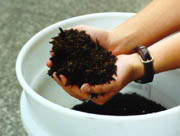How To Compost
Select a place to put a bin or pile. Some general tips for choosing
a site include: 1. Good drainage below the pile or bin, 2. Protection from
fierce winds, 3. Ease of access for adding materials to the pile, 4. Relatively
level ground, 5. Sunny spot( don't let your pile dry out though), 6. Shady
spot (Does not dry out as fast)
Construct a compost pile (on the ground) or a compost bin. Building
a pile is easy to do and inexpensive (actually it's free). The only materials
needed are organic materials (food), Air, and Water. You may also need
garden gloves, a pitchfork, and a shovel to handle the decaying materials.
The drawbacks to just building a pile are animals can easily raid your
pile especially if the pile contains food scraps and it is not as tidy
opposed to composting in a bin. It is not as fast as using a bin. Using
a bin is the preferred way to compost although you may have to purchase
materials to build the bin. Obviously a bin is somewhat contained so it
is cleaner and prevents animal pests from stealing future humus. There
are many bins available to purchase or simply build your own. Its as easy
as taking snow fencing and four posts and constructing 3'x3'x3' square.
Do not build a bin larger than 5'x5'x5' for a bin of this size prevents
air from circulating through the pile.
The process in which organic materials are converted into a usable media
is caused by microbes. Aerobic (requiring Oxygen) and Anaerobic (can not
live in oxygen). Aerobic microbes decompose materials quicker and thus
they are preferred. Anaerobic bacteria breakdown materials as well but
release a strong stench. Microbes are found in soil and manure. More microbes
will enter your pile if your pile is on the earth and not elevated off
of the ground. Adding slightly decomposed manure from vegetarian animals
will hasten the decomposition process especially for decomposing woody
(high carbon) materials. you want to mix organic materials with a carbon:nitrogen
ratio in mind. A ratio of 30:1 is an optimal level. Also keep in mind the
greater variety of materials used will result in finished compost with
a greater variety of essential nutrients. Before filling your bin or pile,
chop or shred the materials into 1 inch pieces (quickens decomposition)
do not make materials smaller to avoid compaction. So when assembling your
pile alternate layers of carbon materials (dead leaves, tree branches),
nitrogen (fresh cut grass, food scraps) and add a few hand fulls of soil
and manure throughout the pile. To avoid compaction make the layers 3"-5"
thick. Piles containing Aerobic bacteria (hot piles) can reach temperatures
of 194 degrees Fahrenheit under these conditions pathogens and weed seeds
are destroyed. Additionally at these temps the bacteria are working their
hardest to decompose the materials. You can measure the heat of your pile
with a compost thermometer after your compost has reached an optimal temp
turn and mix the pile so all ingredients have a chance to be in the center
of the pile (the hottest part of the pile). You don't need a thermometer,
as a rule of thumb rotate your pile every two weeks. You also want moisture
in your pile. Optimal moisture levels are between 40-60% moisture. An easy
way to gauge the moisture of a pile is to grab a handful of compost and
squeeze it. It should have the moisture of a wrung out sponge. Cover your
pile during rainy conditions and if you have to add water to the pile,
poke holes in your pile or mix water in as you turn the pile.
Using a hot pile can produce finished compost within 6 weeks. A cold
pile (without oxygen) can take up to 2 years to produce humus. So I recommend
building a hot pile.
Quick Checklist:
1. Select a site to put your pile or bin.
2. Build your pile or bin.
3. Feed your pile organic materials in a 30:1 carbon : nitrogen ratio.
4. Alternate layers of green and browns and do not forget the manure.
5. 40-60% moisture throughout the pile.
6. Good air flow through the pile.

So after maintaining your pile and following the rules of composting
you should have a rich, earthy smelling substance or humus. You
are now ready to apply your finished compost!
<Last Page Front Page
Applying
Compost>
